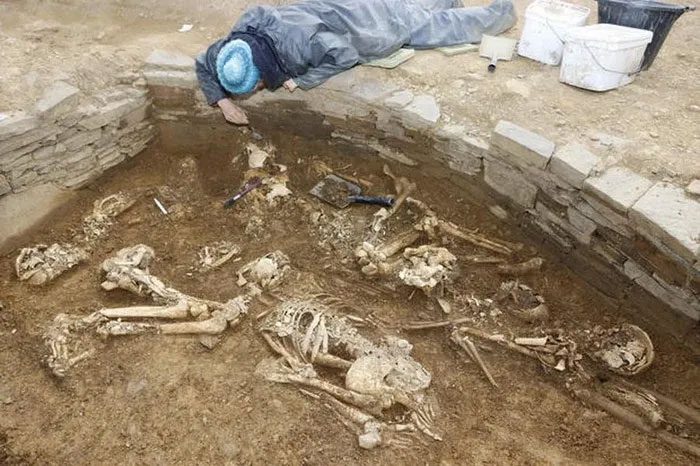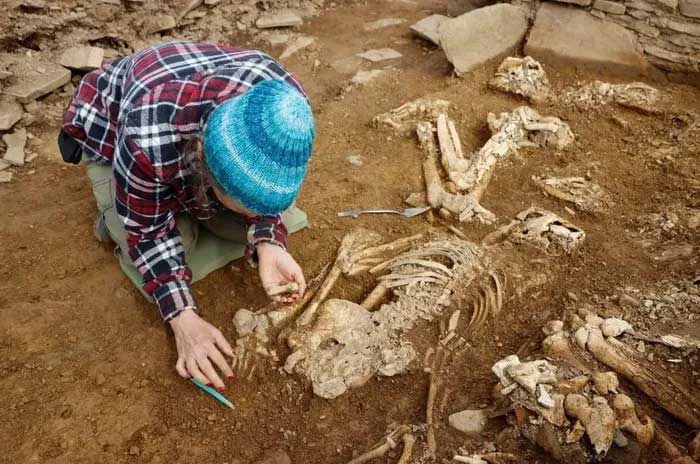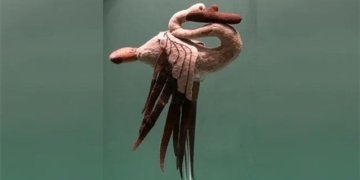Archaeologists have conducted excavations at Holm, East Mainland, in the Orkney Islands, located in the northeastern part of Scotland, where they discovered an ancient stone burial chamber dating back to 3000 BC, showcasing the architectural and construction techniques of the Neolithic period in Northern England.

Archaeologists discovered 14 prehistoric human skeletons in an ancient burial chamber in the Orkney Islands, northeastern Scotland. (Photo: National Museums Scotland)
Inside the burial chamber, scientists excavated six rooms and uncovered 14 human skeletons belonging to men, women, and children. Notably, two skeletons were found in a nearly embracing position, with two children placed above their heads.
The exact location of this ancient burial chamber has long been a mystery, even though records of it date back to the 19th century.
According to The Guardian, in 2020, Hugo Anderson-Whymark, a senior curator of Early Prehistoric at the National Museum of Scotland, stumbled upon an article published over a century ago while researching archival materials.
The article, published in 1896, reported that the son of a farmer in the Orkney Islands discovered traces of an ancient tomb while exploring his family home on a farm in Holm, East Mainland.

The skeletons were found in 6 rooms within the burial chamber. (Source: CBS News)
Anderson-Whymark stated: “It was like a detective story. Coincidentally, we also had other documents in the archives, including a sketch of the farmer’s family’s farm location.”
In the summer of 2023, archaeologists visited the site, which is a gently sloping grassy field with no visible signs of the burial chamber. However, immediately after removing the turf, they quickly uncovered the first traces.
The excavation revealed a burial mound measuring 15 meters in diameter, reinforced with stone walls.
Hugo Anderson-Whymark described: “This is an incredibly impressive structure, built with strong stone architecture. The components in this structure are considered the pinnacle of Neolithic construction techniques.”
The burial chamber is constructed with corbelled stonework, in which prehistoric builders meticulously constructed the stone walls to gradually narrow towards the top of the structure.
It appears that the chamber had stone columns above, but many of the stones have been removed, Anderson-Whymark noted.
Archaeologist Vicki Cummings, head of the Department of History, Archaeology and Religion at Cardiff University in the UK, who co-directed the excavation, said: “The preservation of so many skeletons in one part of this ancient burial chamber is astonishing, especially considering that much of the burial stones have been stolen for building materials.”

The prehistoric skeletons from 5,000 years ago. (Photo: National Museums Scotland)
Ms. Cummings added: “It is very rare to find prehistoric skeletons in such ancient tombs, even with well-preserved tombs. These remains will provide valuable information to help us better understand the lives of people who existed thousands of years ago.”
To date, only 12 similar tombs have been discovered in the Orkney Islands. This type of tomb is referred to as Maes Howe-style passage graves. However, those 12 tombs are located on land, unlike this ancient 5,000-year-old tomb, which has been buried underground.
Most of the burial chamber was destroyed in the late 18th or early 19th century to obtain stones for building the farm.
“In 1896, the farmer and his son, after discovering the burial chamber, took away some artifacts, including a stone hammer and a ball, but they were not interested in the human remains inside and buried everything back,” Anderson-Whymark noted.
In the same year, local archaeologist James Walls Cursiter discovered 8 human skeletons in the burial chamber, from which he hypothesized that the area was an ancient tomb that had been destroyed.
Many documents from Cursiter’s private collection contain numerous clues that are key for today’s archaeologists to conduct a geophysical survey to accurately determine the locations of the surrounding tombs and expand the excavation.




















































